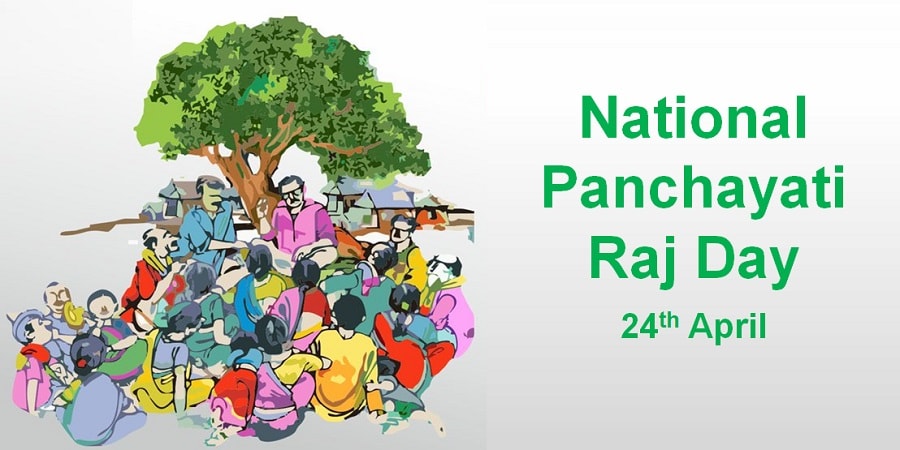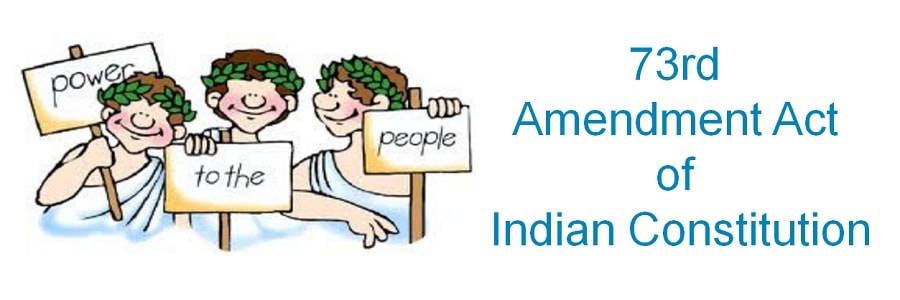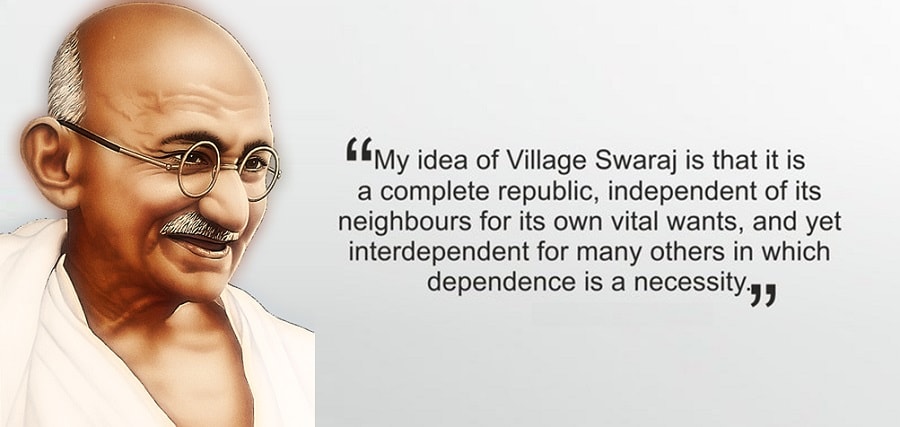Contents
Panchayati Raj System
73rd amendment act
- Article 243 to 243-O, Part-IX
- 11th Schedule of Indian constitution.
- The term Panchayati Raj system in India signifies the system of rural local self-government.
- Panchayati Raj system in India established in all the states by the Acts of the state legislatures.
- Its aim to build democracy at the grass root level.
- Panchayati Raj is entrusted with rural development.
- It was constitutionalized through the 73rd Constitutional Amendment Act of 1992.
Panchayati Raj System

>>>>>>
Evolution of Panchayati Raj in India
Balwant Rai Mehta Committee – 1957
- Government of India appointed Balwant Rai Mehta Committee to examine the working of
- Balwant Rai Mehta Committee recommended establishment of the scheme of ‘democratic decentralisation’.
- It ultimately came to be known as Panchayati Raj system.
Recommendations
- Establishment of a three–tier panchayati raj system
- Gram panchayat at the village level
- Panchayat samiti at the block level
- Zila parishad at the district level
- These tiers should be organically linked through adevice of indirect elections.
- The village panchayat should be constituted with directly elected,
- Panchayat samiti and zila parishad should be constituted with indirectly elected members
- All planning and development activities should be entrusted to these bodies.
- The panchayat samiti should be the executive body while the zila parishad should be the advisory
- The district collector should be the chairman of the zila parishad.
Implementations
- Recommendations of the Balwant Rai Mehta committee were accepted by the National Development Council in Jan 1958.
- The council left it to the states to evolve their own patterns suitable to local conditions.
- Rajasthan was the 1st state to establish Panchayati Raj system, in Nagaur district, 2 Oct 1959.
- 2nd was Andhra Pradesh, who adopted Panchayati Raj system.
Ashok Mehta Committee – 1977
- Janata Government appointed Ashok Mehta committee on panchayati raj system.
- Recommendations of Ashok Mehta Committee
- Two-tier system
- Zila parishad – district level
- Mandal panchayat – a group of villages
- Panchayati raj institutions have compulsory powers of taxation
- Reservation of seats for weaker sections
- Two seats for women members
- Two-tier system
G V K Rao Committee – 1985
- The Committee to review the existing administrative arrangements for Rural Development and Poverty Alleviation Programmes.
L M Singhvi Committee – 1986
- Rajiv Gandhi govt. appointed this committee
- Target was to prepare a concept paper on ‘Revitalisation of Panchayati Raj Institutions for Democracy and Development’
Thungon Committee – 1988
- A sub-committee of the Consultative Committee of Parliament was constituted to examine the political and administrative structure in the district for the purpose of district planning.
Gadgil Committee – 1988
- Gadgil Committee was asked to consider the question of “how best Panchayati Raj institutions could be made effective”.
- Recommendations of Gadgil Committee
- A constitutional status should be bestowed on the Panchayati Raj system.
- Establishment of a State Finance Commission
- Establishment of a State Election Commission
- Term of Panchayati Raj institutions should be fixed at 5 years.
- Members of the Panchayats at all the 3 levels should be directly elected.
Constitutionalisation of Panchayati Raj System
- Rajiv Gandhi Government introduced the 64th Constitutional Amendment Bill in the Lok Sabha in July 1989.
- Rajya Sabha dropped the bill
- In 1989 National Front Govt, under Prime Minister V P Singh, announced that it would take steps to strengthen the panchayati raj system.
- In June 1990, a two-day conference of the state chief ministers under the chairmanship of V P Singh was held to discuss the issues relating to the strengthening of the panchayati raj bodies.
- Congress Government under prime minister P V Narasimha Rao, considered the matter of the constitutionalism of panchayati raj bodies.
- It drastically modified the proposals in this regard to delete the controversial aspects and introduced a constitutional amendment bill in the Lok Sabha in September, 1991.
- This bill finally emerged as the 73rd Constitutional Amendment Act, 1992 and came into force on 24 April, 1993
>>>>>>>

>>>>>>>
73rd Amendment Act of 1992
Significance of the Act
- 11th schedule of Indian constitution contains 29 functional items of the panchayats.
- It deals with Article 243-G.
- The act has given a practical shape to Article 40 of the Constitution
- The provisions of the act can be grouped into two categories—compulsory and voluntary.
- The compulsory provisions of the act have to be included in the state laws creating the new panchayati raj system.
Gram Sabha
- Article 243A
- The act provides for a Gram Sabha as the foundation of the panchayati raj system.
- It is a village assembly consisting of all the registered voters in the area of a panchayat.
- It may exercise powers and perform functions at the village level as the legislature of a state determines.
Three-Tier Panchayati Raj System
- The act provides for a three-tier panchayati raj system in every state.
- Panchayats at the
- village levels
- intermediate levels
- district levels
- It brings about uniformity in the structure of panchayati raj system throughout the country.
- State having a population not exceeding 20 lakh may not constitute panchayats at the intermediate level.
Election of Members & Chairpersons
- All the members of panchayats at the village, intermediate and district levels shall be elected directly by the people.
- Chairperson of intermediate and district levels shall be elected indirectly from among the elected members.
- Chairperson of a panchayat at the village level shall be elected in such manner as the state legislature determines.
Reservation of Seats
- Article 243D
- Seats shall be reserved
- As per the population of the Scheduled Castes and the Scheduled Tribes.
- min 1/3 of the total number of seats for women (including the women belonging SCs and STs).
- min 1/3 of the total number of chairpersons at each level shall be reserved for women.
Duration of Panchayats
- The act provides for a 5 year term of office to the panchayat at every level.
- Panchayat reconstituted after premature dissolution, remains in office only for the remainder of the period.
State Election Commission
- Article 243K
- Preparation of electoral rolls and the conduct of all elections to the panchayats shall be vested in the state election commission.
- It consists of a state election commissioner to be appointed by the governor.
- His conditions of service and tenure of office shall also be determined by the governor.
- He can be removed from the office in same manner and on the grounds of a judge of the state high court.
State Finance Commission
- Article 243I
- The governor of a state shall, after every 5 years, constitute a finance commission.
- It review the financial position of the panachayats.
- It make recommendations to the Governor
- The distribution between the state and panchayats of the net proceeds of the taxes, duties, tolls and fees levied by the state.
- The grants-in-aid to panchayats from the consolidated fund of the state.
- The measures needed to improve the financial position of panchayats.
- Any other matter referred to it by the governor in the interests of sound finance of panchayats.
Application to Union Territories
- The president of India may direct that the provisions of this act shall apply to any union territory
Exempted States & Areas
- The act does not apply to the states of J&K, Nagaland, Meghalaya and Mizoram and certain other areas.
- These areas include
- the scheduled areas and the tribal areas in the states
- the hill area of Manipur for which a district council exists
- Darjeeling district of West Bengal
Bar to Interference by Courts in Electoral Matters
- Article 243O
- It declares that the validity of any law relating to the delimitation of constituencies or the allotment of seats to such constituencies cannot be questioned in any court.
- It further lays down that no election to any panchayat is to be questioned except by an election petition presented to such authority and in such manner as provided by the state legislature.
11th Schedule of Indian Constitution
- It contains the following 29 functional items placed within the purview of panchayats
- Agriculture, including agricultural extension
- Land improvement, implementation of land reforms, land consolidation and soil conservation
- Minor irrigation, water management and watershed development
- Animal husbandry, dairying and poultry
- Fisheries
- Social forestry and farm forestry
- Minor forest produce
- Small-scale industries, including food processing industries
- Khadi, village and cottage industries
- Rural housing
- Drinking water
- Fuel and fodder
- Roads, culverts, bridges, ferries, waterways and other means of communication
- Rural electrification, including distribution of electricity
- Non-conventional energy sources
- Poverty alleviation programme
- Education, including primary and secondary schools
- Technical training and vocational education
- Adult and non-formal education
- Libraries
- Cultural activities
- Markets and fairs
- Health and sanitation including hospitals, primary health centres and dispensaries
- Family welfare
- Women and child development
- Social welfare, including welfare of the handicapped and mentally retarded
- Welfare of the weaker sections, and in particular, of the scheduled castes and the scheduled tribes
- Public distribution system
- Maintenance of community assets
Compulsory Provisions of 73rd Amendment Act
- Organisation of Gram Sabha in a village or group of villages.
- Establishment of panchayats at the village, intermediate and district levels.
- Direct elections to all seats in panchayats at the village, intermediate and district levels.
- Indirect elections to the post of chairperson of panchayats at the intermediate and district levels.
- 21 years to be the minimum age for contesting elections to panchayats.
- Reservation of seats (both members and chairpersons) for SCs, STs and for women in panchayats at all 3 levels.
- Fixing tenure of 5 years for panchayats at all levels.
- Holding fresh elections within 6 months in the event of supersession of any panchayat.
- Establishment of a State Election Commission for conducting elections to the panchayats.
- Constitution of a State Finance Commission after every 5 years to review the financial position of the panchayats.
Voluntary Provisions
- Article 243H
- Authorizing panchayats to levy, collect and appropriate taxes, duties, tolls and fees.
>>>>>>

>>>>>>
PESA Act of 1996 (Extension Act)
- According to the PESA Act, the provisions of Panchayati raj system are not applicable to the 5th Schedule areas.
- Parliament may extend these provisions to such areas
- Parliament has enacted the “Provisions of the Panchayats (Extension to the Scheduled Areas) Act”, 1996, popularly known as the PESA Act or the Extension Act.
- At present, 10 states have 5th Schedule Areas are under PESA Act.
- These are: Andhra Pradesh, Telangana, Chhatisgarh, Gujarat, Himachal Pradesh, Jharkhand, Madhya Pradesh, Maharashtra, Odisha and Rajasthan.
Objectives of the PESA Act
- To extend the provisions of panchayats to the 5th scheduled areas with certain modifications (not 6th scheduled).
- To provide self–rule for the bulk of the tribal population.
- To have village governance with participatory democracy and to make the gram sabha a nucleus of all activities.
- To evolve a suitable administrative framework consistent with traditional practices.
- To safeguard and to preserve the traditions and customs of tribal communities.
Features of the Act
- Gram Sabha shall safeguard
- traditions and customs
- cultural identity
- community resources
- customary mode of dispute resolution
- Gram Sabha shall approve of the plans for social and economic development before implementation by the Panchayat at the village level.
- Gram Sabha responsible for the identification of beneficiaries under the poverty alleviation and other programmes.
- The reservation of seats in the Scheduled Areas in every Panchayat shall be in proportion to the population of the communities.
- Reservation for the Scheduled Tribes shall not be less than 50% of total seats.
- All seats of Chairpersons of Panchayats at all levels shall be reserved for the Scheduled Tribes.
- State government may nominate such Scheduled Tribes which have no representation in intermediate or district level.
- Such nomination shall not exceed 10% of the total members to be elected in that Panchayat.
- The prior recommendation of the Gram Sabha or the Panchayats at the appropriate level shall be mandatory for grant of concession for the exploitation of minor minerals by auction or licence.
- Panchayats in the Scheduled Areas with such powers and authority need to function as institutions of self-government
- The State Legislature follow the pattern of the 6th Schedule to the Constitution administrative arrangements in the Panchayats at district levels in Scheduled Areas.
Finances of Panchayati Raj System in India
- Across the country, States have not given adequate attention to fiscal empowerment of the Panchayats.
- Kerala, Karnataka and Tamil Nadu are the states which are considered to be progressive in PRIs empowerment.
- But even there, the Panchayats are heavily dependent on government grants.
Single Stage Panchayati Raj System
- J&K – District Development Councils
- Meghalaya (don’t have panchayat)
- Mizoram (don’t have panchayat)
- Nagaland (don’t have panchayat)
Two Stages Panchayati Raj System
- Arunachal Pradesh
- Goa
- Sikkim
Four Stages Panchayati Raj System
- Assam
- Tripura
Notes
- 73rd amendment act bill was passed by the Lok Sabha on 22 Dec 1992, and Rajya Sabha on 23 Dec 1992.
- Later, it was approved by the 17 state assemblies and received the assent of the president on 20 April 1993.
- Madhya Pradesh holds 1st panchayat elections under the 73rd Amendment act dispensation on 30 May 1994.
Video Explanation
- Panchayati Raj System in Hindi – Part 1
- Panchayati Raj System in Hindi – Part 2
- PESA Act. 1996 in Hindi
- Panchayati Raj System in English
- PESA Act. 1996 in English
>>>>>>




